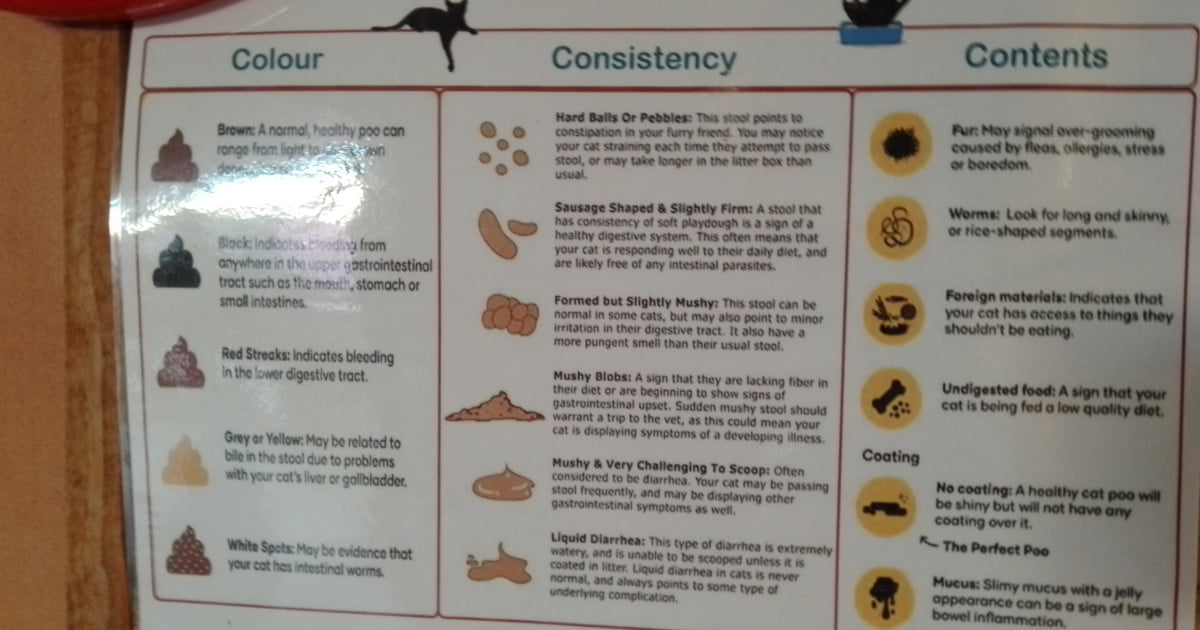Cat Poop Colour Chart
The shade of your cat’s poo reflects what’s happening inside their body.
Normal healthy poo is brown, and other colours of poo can indicate health issues and necessitate a checkup at the vet.
The Cat Poop Colour Chart in the image below tells us a lot about the health of your cat once you examine its poo.

Cat Poop Colour Chart
The shade of your cat’s poo reflects what’s happening inside its body.
Normal healthy poo is brown, and other colours of poo can indicate health issues and necessitate a checkup at the vet.
One of the issues might be that your cat has eaten poisonous plants which should be avoided but are not always easy.
Brown cat poo
Healthy cats produce brown-coloured poo which is firm but pliable.
These poos can range from light to dark brown, according to diet.
Occasional changes in colour are acceptable, but continuing abnormalities should be investigated further.
Black cat poo
Black cat poo indicates bleeding in the upper gastrointestinal tract such as the mouth, stomach or small intestine.
The black colour means that the blood has been digested, especially if the poo is shiny and sticky.
This is a serious health condition and you should immediately take your cat to the vet.
Red streaks in cat poo
Red streaks that occur on just one occasion should not cause panic.
These red streaks typically signal that your cat is bleeding in its large intestine or lower gastrointestinal tract.
However if the streaks continue or if they’re accompanied by changes in your cat’s behaviour, it’s best to see the vet.
Grey or Yellow cat poo
Related to bile due to problems with the liver or gallbladder.
Your cat may also produce a yellow poo if food passes through its intestines too fast.
If this continues, consult the vet.
White spots in cat poo
Small white spots can be evidence of intestinal worms.
Long and skinny roundworms or rice-shaped tapeworm segments are the most common parasites found in your cat’s poo.
The vet can diagnose and treat the type of worm, from a sample of the stool.
Consistency
Hard balls or pebbles
This stool indicates constipation, and the cat may strain when they pass the stool or take longer time than usual in the litter tray.
Untreated constipation can be dangerous and should be treated by the vet.
Sausage shaped and slightly firm
This is a sign of a healthy digestive system. The cat has a healthy diet and is free from internal parasites.
Formed but quite mushy
This may be normal or may indicate minor irritation in the digestive tract. It may smell a little more pungent than usual.
Mushy blobs
A gastrointestinal upset, or lacking fibre. A sudden mushy stool can indicate a developing health problem and should be investigated by the vet.
Mushy diarrhea
The cat may pass this stool frequently and display other gastrointestinal symptoms, and should be taken to the vet.
Liquid diarrhea
A sign of an underlying health problem necessitating a vet visit.
Contents of the Poo
Fur
The cat has been excessively grooming, due to fleas, allergies, stress or boredom.
Worms
Long thin worms or rice-shaped segments.
Foreign materials
The cat has eaten something unusual.
Undigested food
A sign of a poor quality diet.
Coating
Mucus – slimy mucus with a jelly-like appearance indicates large bowel inflammation.
Healthy poo is shiny with no coating.


